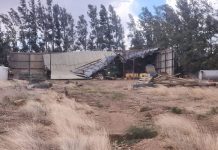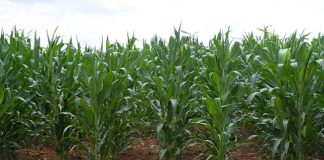The determined uphill march of administered prices – such as water and electricity, fuel, wages and municipal rates and taxes – has a knock-on effect on all levels of the agricultural value chain, from production costs, to storage, processing and retail. Yet farmers are taking steps to mitigate the effects of these prices.
For example, faced by rising fuel prices, which were sitting at R12,22/l for petrol and R10,98/l for wholesale diesel in May in Gauteng, farmers are looking at more fuel-efficient tractors, implements and farming practices. According to John Deere sales manager Leon Pretorius, new products include hi-tech tractors with row guidance, and enhanced yield mapping systems and sophisticated trailed and self-propelled sprayers with automated steer and spray functions.
“Today’s tractor engines and transmissions are electronically controlled to optimise the load on to the tractor and to optimise fuel efficiency. We’re seeing more customers using precision farming, which helps utilise the tractor more efficiently.” You’re also able to apply fertiliser, seed and pesticide more effectively. “Automated steer, which enables the tractor to steer itself, means there’s no overlap on the return path and, on a tillage operation, that drives down fuel costs, and is much more productive and efficient,” said Pretorius.
Their own fuel
Some farmers, meanwhile, have turned to producing their own biodiesel to save money. The primary feedstock suitable for this in SA is canola, sunflower and soya beans. “However, there can be more value to push these crops into food than biodiesel,” admitted Agama Energy’s Greg Austin. “It all hinges around the oil price, government levies and taxes, and the pump price.”
Louis Claasen Jr, who farms near Sasolburg in the Free State, has found this to be the case. He produces on-farm biodiesel from his sunflower crop, which is used to run the farm vehicles. “However, with the current sunflower price at about R5 000/t, it’s not viable to put the sunflower into diesel, so we have stopped for now,” he said.
It’s viable when the sunflower price is between R3 000/t and R4 000/t, he said. Although the initial purchase of the biodiesel plants may be expensive, it does offer grain oil crop farmers, who are exposed to unstable market prices, an alternative avenue when prices drop. And when coupled with a large livestock operation, the farmer can save on diesel and use the oilcake, the remainder of the plant once the oils have been extracted, as feed.
Capitalising on these opportunities is Wynand Theron, who produces biodiesel on a 1ha smallholding in Joostenberg Vlakte on the outskirts of Cape Town. From about 1 500l of used sunflower cooking oil his yield is 80%. This is then sold to transport companies in the vicinity, who buy in bulk 1 000l-tanks. “If I was to use the biodiesel myself, I would save about R2,50/l on the pump price,” said Theron.
The one challenge is that oil must be heated to 55°C for processing. This requires considerable energy, which traditionally comes from Eskom. To cut his operating costs, Theron recently purchased a R27 000 BiogasPro biodigester from Agama Energy. A standard, off-the-shelf unit, it is designed to co-digest 60kg of multiple biowaste a day.
“I feed the biodigester about 20kg of cow manure a day, as well as glycerol, which is a by-product of the biodiesel production process. The idea is to build a gas heater, so we can use the methane from the bio-digester to heat the oil,” explained Theron.
“I won’t have to pay for electricity and I can take the whole operation off the grid.”
Self-powered
Eskom’s 2012/2013 tariff increase, in effect for the 12 months beginning 1 April, was 16%, and comes on top of increases of 34,8% in 2009/2010, 24,8% in 2010/2011 and 25,1% in 2011/2012. At an estimated consumption of 5 485GWh in 2009/2010; 5 567GWh in 2010/2011 and 5 651GWh in 2011/2012, the total estimated cost to the primary agricultural sector was R1,843 billion, R2,314 billion and R2,955 billion respectively, according to the National Agricultural Marketing Council (NAMC).
Some farmers, however, like those in Bushmanland in the Northern Cape, don’t have physical access to Eskom and have long been energy self-sufficient. “I only use windmills and solar panels and have a back-up generator,” said Johan Vollgraaff, who farms with about 4 000 Dorper sheep on 32 000ha outside Brandvlei, halfway between Upington and Calvinia.
“We use a minimum amount of electricity, starting with lights as a basic. To heat water, we use gas heaters and to heat the kettle we use gas or the Aga stove. The fridge and deep freeze run off solar panels and wind power. “If I use power tools, we start the diesel engine. We use windmills to extract water from underground reservoirs for drinking water for the sheep. We also use solar pumps for extracting water from underground.”
Fresh water
Agriculture is the largest consumer of fresh water in South Africa – and takes strain when water prices increase as they have.
The index for water and other services has increased from 111,9 index points in January 2010, to 122,3 points in January 2011 and 196,1 points in January 2012, according to the NAMC. To counteract his high water bill, Ken Walton, CEO of Valley Fresh tomato producers in the Camperdown area of KZN, installed a rainwater capture system on the greenhouse.
Rainwater is channelled off the roof of the 1 800m² greenhouse and from the gutters of buildings into two 100 000l storage reservoirs, covered with 80% shade cloth. “Rainwater supplies 40% of the farm’s needs, with the remainder drawn from the municipality,” said Walton. “In decent rain of 40mm, we harvest in the region of 110 000l. It’s massive. In the early summer rains, we were dumping water because we didn’t have enough storage.”
The greenhouse is locally manufactured by Vegtech SA. A basic rainwater harvest system for a 2 500m² greenhouse, which includes a 100 000l reservoir with net cover, downpipes and reticulation from greenhouse to reservoir and installation (but excludes earthworks, pumps and pipelines), currently costs R80 000 (excl VAT), said Rob Twycross of FilmFlex Plastics, Vegtech SA’s KZN agent. Walton said the harvested rainwater is worth the investment.
“At the moment, I spend R6 000 a month on municipal water. That’s expensive. The more rainwater I can use, the more I can save on my municipal bill. “Another big benefit is the quality of the rainwater. From a hydroponic point of view, that’s critical. Any farmer wants the water as pure as possible.”










